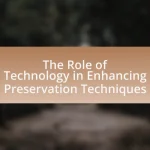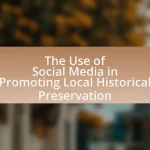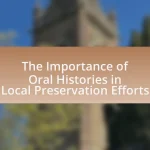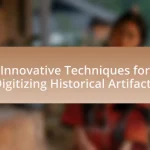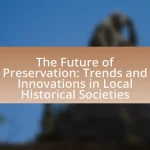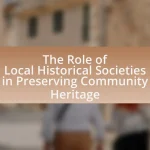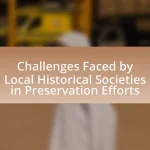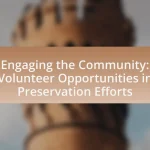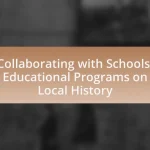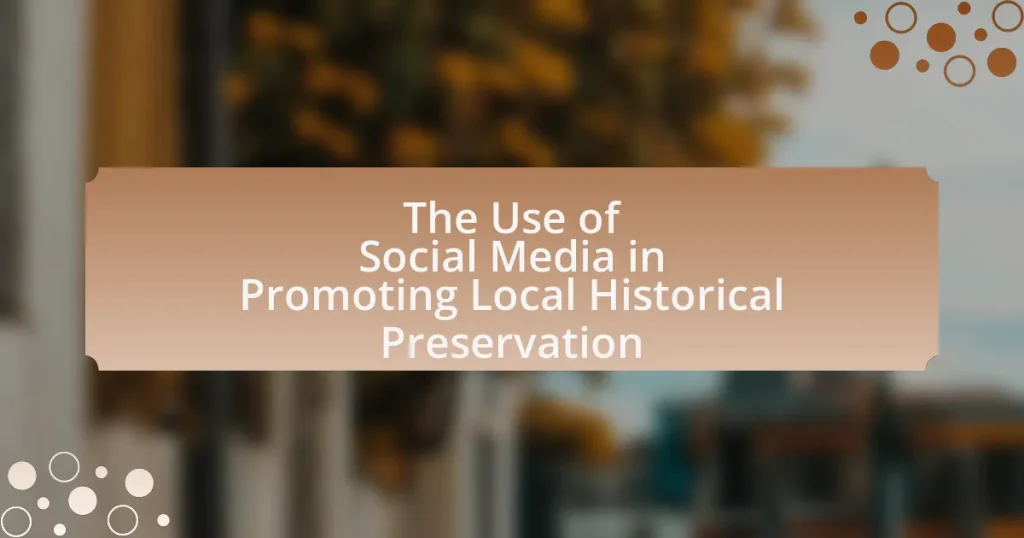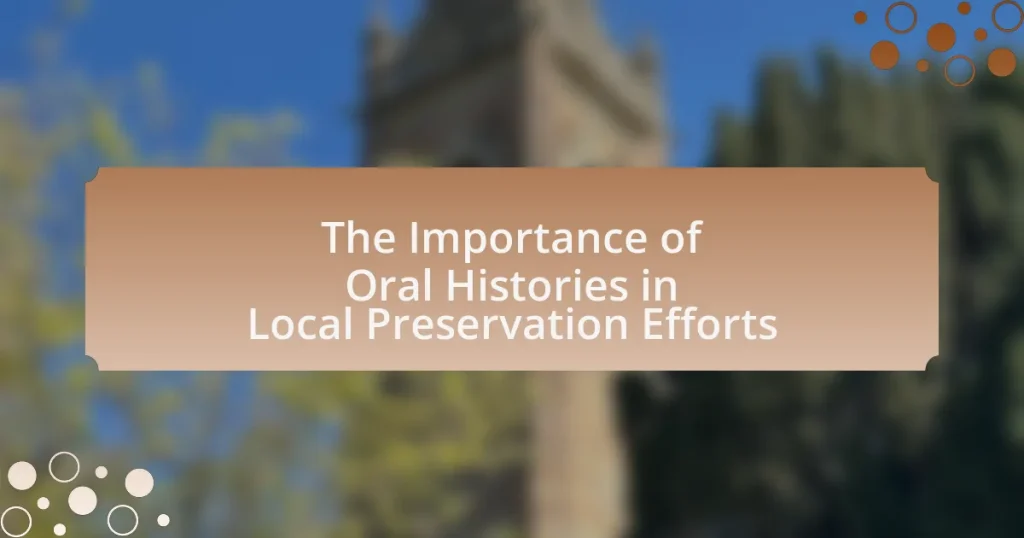Historical societies are organizations focused on preserving and promoting the history of specific localities. They play a vital role in local history by collecting artifacts, documents, and oral histories, and by organizing events and exhibits that engage the community. This article explores how historical societies contribute to preserving local history, the types of resources they provide for research, and the significance of events and exhibits in fostering community awareness and identity. It also discusses best practices for organizing successful events and ensuring inclusivity, highlighting the impact of these initiatives on public understanding of local heritage.
What are Historical Societies and Their Role in Local History?
Historical societies are organizations dedicated to preserving, interpreting, and promoting the history of a specific locality or region. They play a crucial role in local history by collecting artifacts, documents, and oral histories that reflect the community’s past, thereby fostering a sense of identity and continuity among residents. Historical societies often organize events, exhibits, and educational programs that engage the public and raise awareness about local heritage, contributing to historical scholarship and community pride. For instance, many historical societies maintain museums or archives that serve as resources for researchers and the general public, ensuring that local history is accessible and appreciated.
How do Historical Societies contribute to preserving local history?
Historical societies contribute to preserving local history by collecting, archiving, and sharing artifacts, documents, and narratives that reflect the community’s heritage. They often maintain museums and historical sites that serve as educational resources, allowing the public to engage with local history through exhibits and events. For example, many historical societies organize annual events such as heritage festivals or historical reenactments, which not only celebrate local traditions but also foster community involvement and awareness of historical significance. Additionally, they often collaborate with schools and local governments to promote historical education, ensuring that future generations understand and appreciate their local history.
What types of resources do Historical Societies provide for local history research?
Historical societies provide a variety of resources for local history research, including archival materials, historical documents, photographs, maps, and oral histories. These resources are essential for researchers seeking to understand the historical context of their communities. For example, many historical societies maintain collections of primary sources such as letters, diaries, and official records that offer firsthand accounts of local events. Additionally, they often host workshops and lectures that educate the public about local history, further enhancing the research experience.
How do Historical Societies engage with the community to promote local history?
Historical societies engage with the community to promote local history through a variety of programs and events, including educational workshops, public lectures, and community exhibits. These initiatives often involve collaboration with local schools, libraries, and other organizations to enhance public awareness and appreciation of local heritage. For example, many historical societies organize annual heritage festivals that showcase local traditions, artifacts, and stories, thereby fostering community involvement and interest in preserving local history. Additionally, societies may offer guided tours of historical sites, which provide firsthand experiences and insights into the area’s past, further solidifying community ties to local history.
Why are events and exhibits important for celebrating local history?
Events and exhibits are crucial for celebrating local history because they provide a platform for community engagement and education. These gatherings allow individuals to connect with their heritage, fostering a sense of identity and belonging. Historical societies often curate these events to showcase artifacts, stories, and traditions that reflect the unique narrative of the area. For instance, local festivals may feature reenactments or displays that highlight significant historical events, making history accessible and relatable to attendees. This interactive approach not only preserves local history but also encourages participation from diverse community members, ensuring that the history is remembered and valued across generations.
What impact do events and exhibits have on community awareness of local history?
Events and exhibits significantly enhance community awareness of local history by providing interactive and engaging platforms for education and discussion. These activities often feature artifacts, storytelling, and expert presentations that connect residents to their heritage, fostering a sense of identity and belonging. For instance, a study by the American Alliance of Museums found that 85% of participants in local history events reported increased knowledge about their community’s past. This direct engagement not only informs attendees but also encourages them to share their newfound knowledge, thereby amplifying the impact on broader community awareness.
How do events and exhibits foster a sense of identity and belonging among residents?
Events and exhibits foster a sense of identity and belonging among residents by providing opportunities for community engagement and cultural expression. These gatherings allow individuals to connect with their local history, traditions, and shared experiences, reinforcing a collective identity. For instance, historical societies often organize events that showcase local heritage, which can lead to increased pride and recognition of a community’s unique narrative. Research indicates that participation in community events enhances social cohesion and belonging, as residents feel more connected to one another through shared activities and knowledge of their history.
What Types of Events are Organized by Historical Societies?
Historical societies organize a variety of events, including lectures, workshops, guided tours, reenactments, and exhibitions. These events aim to educate the public about local history and heritage. For instance, lectures often feature historians or experts discussing specific historical topics, while workshops may involve hands-on activities related to historical crafts or skills. Guided tours typically explore significant historical sites, providing context and stories about the area. Reenactments bring historical events to life, allowing participants to experience history in an engaging way. Exhibitions showcase artifacts and documents, often highlighting particular themes or periods in local history.
What are the most common types of events hosted by Historical Societies?
Historical societies commonly host events such as lectures, workshops, guided tours, and exhibitions. These events aim to educate the public about local history and heritage. For instance, lectures often feature historians or experts discussing significant historical topics, while workshops may involve hands-on activities related to historical crafts or research methods. Guided tours typically explore historical sites or neighborhoods, providing insights into their significance. Exhibitions showcase artifacts, documents, and photographs that illustrate the community’s past, often attracting visitors interested in learning more about their local history.
How do educational workshops enhance understanding of local history?
Educational workshops enhance understanding of local history by providing interactive, hands-on experiences that engage participants in the historical narrative of their community. These workshops often include activities such as artifact handling, storytelling, and discussions led by local historians, which facilitate deeper connections to historical events and figures. Research indicates that experiential learning, such as that found in workshops, significantly improves retention and comprehension of historical facts, as evidenced by studies showing that participants in interactive settings retain up to 75% of the information compared to 10% in traditional lecture formats.
What role do historical reenactments play in engaging the public?
Historical reenactments play a significant role in engaging the public by providing immersive experiences that bring history to life. These events allow participants and spectators to witness and interact with historical events, fostering a deeper understanding of the past. For instance, reenactments often include accurate costumes, period-appropriate settings, and scripted events based on historical facts, which enhance educational value and stimulate interest in local history. Research indicates that such interactive learning experiences can improve retention of historical knowledge, as evidenced by studies showing that participants in reenactments demonstrate greater historical awareness compared to traditional learning methods.
How do Historical Societies promote their events to the community?
Historical societies promote their events to the community through a combination of social media, newsletters, local partnerships, and community outreach initiatives. These organizations utilize platforms like Facebook, Twitter, and Instagram to reach a broader audience, sharing event details and engaging with community members. Additionally, they often distribute newsletters to their members and local residents, providing updates on upcoming events and activities. Collaborating with local businesses and schools helps to enhance visibility and encourage participation. Historical societies also engage in outreach efforts, such as hosting informational sessions or participating in community fairs, to raise awareness about their events and the importance of local history.
What marketing strategies are effective for attracting attendees to local history events?
Effective marketing strategies for attracting attendees to local history events include targeted social media campaigns, partnerships with local schools and community organizations, and engaging storytelling that highlights the unique aspects of the event. Social media platforms like Facebook and Instagram allow for precise targeting of demographics interested in history, increasing visibility and engagement. Collaborating with schools can facilitate field trips or educational programs, drawing in students and their families. Additionally, using storytelling techniques in promotional materials can evoke emotional connections, making the events more appealing. Research indicates that events with strong community ties and engaging narratives see higher attendance rates, as they resonate more with potential attendees.
How can social media be utilized to increase participation in events?
Social media can be utilized to increase participation in events by creating targeted campaigns that engage specific audiences. For instance, historical societies can leverage platforms like Facebook and Instagram to share visually appealing content related to local history, such as photos of past events or sneak peeks of upcoming exhibits. Research indicates that posts with images receive 94% more views than text-only posts, enhancing visibility and interest. Additionally, using event pages on social media allows for easy RSVP options, reminders, and updates, which can boost attendance. A study by Eventbrite found that 62% of event organizers reported increased attendance through social media promotion, demonstrating its effectiveness in driving participation.
What Types of Exhibits are Curated by Historical Societies?
Historical societies curate a variety of exhibits that focus on local history, cultural heritage, and significant events. These exhibits often include artifacts, photographs, documents, and multimedia presentations that highlight the community’s past, notable figures, and historical milestones. For instance, many historical societies organize themed exhibits around specific time periods, such as the Civil War or the Industrial Revolution, showcasing relevant items and narratives that educate the public about their local significance. Additionally, traveling exhibits may be curated to feature broader historical themes, allowing communities to engage with national or global history through a local lens.
How do Historical Societies select themes for their exhibits?
Historical societies select themes for their exhibits based on community interests, historical significance, and educational value. They often conduct surveys or engage with local residents to identify topics that resonate with the community, ensuring relevance and engagement. Additionally, historical significance is assessed by examining local history, events, and figures that have shaped the area, which helps in curating exhibits that reflect the unique heritage of the community. Educational value is also a key factor, as societies aim to provide informative content that enhances public understanding of historical contexts.
What criteria are used to choose artifacts and materials for exhibits?
Artifacts and materials for exhibits are chosen based on criteria such as historical significance, relevance to the theme, condition and preservation needs, and educational value. Historical significance ensures that the items represent important events, figures, or cultural aspects of the local history, while relevance to the theme aligns the artifacts with the specific narrative or message of the exhibit. The condition and preservation needs of the artifacts are assessed to determine their suitability for display, as items in poor condition may require special handling or may not be displayed at all. Lastly, educational value is considered to ensure that the artifacts can effectively engage and inform the audience about the local history being celebrated.
How do exhibits reflect the diverse narratives of local history?
Exhibits reflect the diverse narratives of local history by showcasing artifacts, stories, and perspectives from various cultural, social, and economic backgrounds within a community. These exhibits often include contributions from local residents, oral histories, and multimedia presentations that highlight underrepresented voices and experiences. For instance, a local history exhibit might feature items from Indigenous communities, immigrant populations, and other marginalized groups, thereby providing a more comprehensive understanding of the area’s past. This approach not only educates visitors about the multifaceted nature of local history but also fosters a sense of belonging and recognition among diverse community members.
What are the benefits of visiting exhibits organized by Historical Societies?
Visiting exhibits organized by Historical Societies offers educational enrichment, community engagement, and preservation of local heritage. These exhibits provide visitors with insights into regional history, showcasing artifacts and narratives that enhance understanding of cultural and historical contexts. For instance, a study by the American Association for State and Local History found that 85% of visitors reported increased knowledge about their community’s history after attending such exhibits. Additionally, these events foster social connections among attendees, promoting a sense of belonging and shared identity. Historical Societies also play a crucial role in preserving artifacts and stories, ensuring that future generations can access and learn from their local history.
How do exhibits enhance public understanding of historical events and figures?
Exhibits enhance public understanding of historical events and figures by providing tangible, visual representations of history that engage audiences. These displays often include artifacts, documents, and multimedia presentations that contextualize historical narratives, making them more relatable and accessible. For instance, a local history exhibit might showcase photographs and personal stories from community members, illustrating the impact of a significant event on everyday lives. This immersive experience fosters a deeper emotional connection and encourages critical thinking about the past, ultimately leading to a more informed public.
What opportunities do exhibits provide for community engagement and dialogue?
Exhibits provide significant opportunities for community engagement and dialogue by facilitating interactions between diverse groups and fostering discussions about local history. These events allow community members to share personal stories, perspectives, and cultural heritage, creating a platform for collective reflection and understanding. For instance, historical societies often organize workshops and panel discussions during exhibits, encouraging participants to engage in meaningful conversations about their shared past. This interactive approach not only enhances the educational experience but also strengthens community bonds, as evidenced by studies showing increased social cohesion in areas with active historical engagement initiatives.
What Best Practices Can Historical Societies Follow for Successful Events and Exhibits?
Historical societies can follow several best practices for successful events and exhibits, including thorough planning, community engagement, and effective marketing. Thorough planning involves setting clear objectives, timelines, and budgets, which ensures that all aspects of the event are organized and executed efficiently. Community engagement is crucial; involving local residents and stakeholders can enhance participation and foster a sense of ownership, as evidenced by studies showing that community-driven events attract larger audiences. Effective marketing strategies, such as utilizing social media and local partnerships, can significantly increase visibility and attendance, with research indicating that targeted outreach can boost event participation by up to 50%.
How can Historical Societies effectively gather feedback from event attendees?
Historical societies can effectively gather feedback from event attendees by utilizing surveys, both online and paper-based, immediately following the event. These surveys can include specific questions about the event’s content, organization, and overall experience, allowing attendees to provide detailed insights. Research indicates that post-event surveys yield a higher response rate when distributed promptly, as attendees are more likely to remember their experiences. Additionally, offering incentives, such as discounts on future events or membership benefits, can further encourage participation in feedback collection.
What strategies can be implemented to ensure inclusivity in events and exhibits?
To ensure inclusivity in events and exhibits, organizers should implement strategies such as accessible venue selection, diverse programming, and community engagement. Accessible venue selection involves choosing locations that accommodate individuals with disabilities, ensuring compliance with the Americans with Disabilities Act (ADA) standards. Diverse programming includes featuring a variety of cultural perspectives and narratives, which can attract a broader audience and foster a sense of belonging. Community engagement can be achieved by collaborating with local organizations and underrepresented groups to gather input and co-create content, thereby reflecting the community’s diversity. These strategies are supported by research indicating that inclusive practices enhance participation and satisfaction among diverse audiences.
